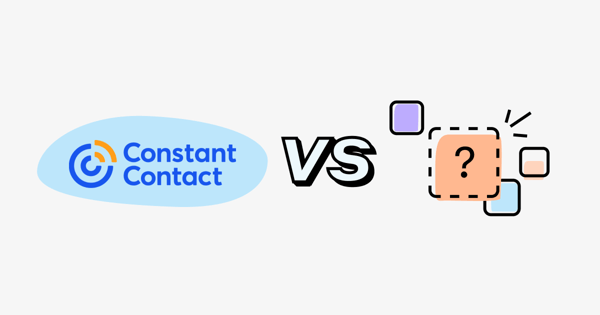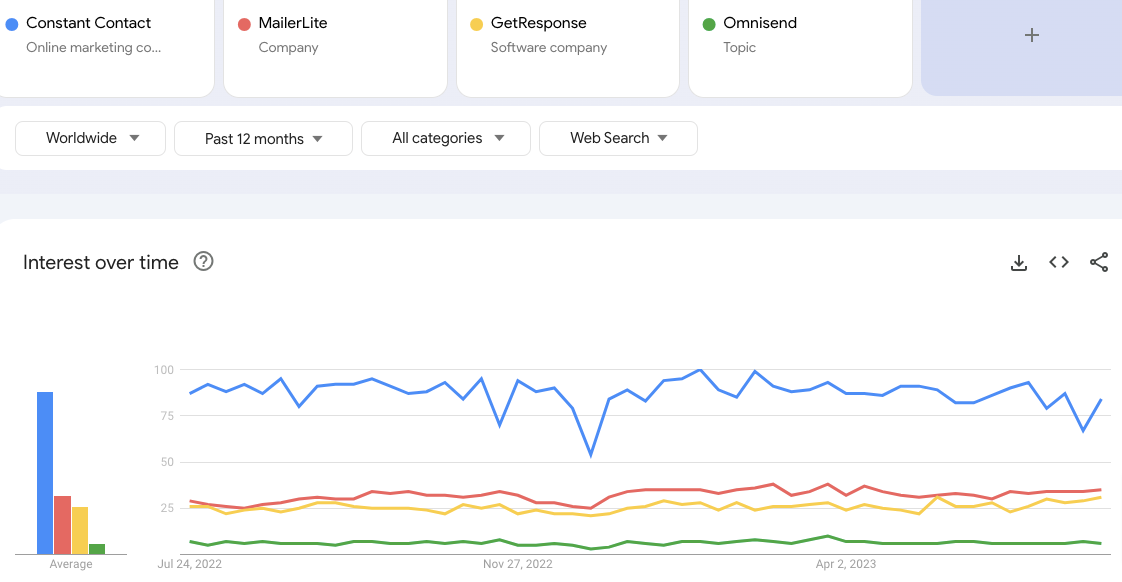Launched way back in 1995, Constant Contact is practically geriatric in the fast-moving world of digital marketing.
This longevity has helped it build one of the strongest brands on the market…
…but it also leaves the platform open to competition from younger, smaller, more agile disruptors.
Which begs the obvious question: are there better Constant Contact alternatives out there?
To help answer it, we’ve rounded up 10 of the best alternatives to Constant Contact and compared them across the following criteria:
- Price
- Product features
- Customer support
- Pros and cons
- Target audience
Let’s dive in…
What Are the Best Constant Contact Alternatives?
| Constant Contact Alternatives | Best For | Top Features | Pricing/Month |
| Drip | DTC ecommerce | Segment your whole audience based on real-time store, visitor, and marketing data. | From $39 per month for up to 2,500 contacts and unlimited email sends. |
| Klaviyo | Ecommerce agencies and developers | Personalization and segmentation tools allow you to create customer segments based on real-time data. | Free for up to 250 contacts and 500 monthly email sends; paid plans priced from $45 per month for up to 1,000 contacts and 10,000 monthly email sends. |
| Mailchimp | Small businesses | Advanced analytics and reporting help marketers make data-driven decisions. | Free for up to 500 contacts and 1,000 monthly email sends; paid plans start at $9.99 per month for 500 contacts and 5,000 monthly email sends. |
| Omnisend | Ecommerce marketers | Web push notifications allow brands to instantly retarget customers. | Free to reach up to 250 contacts per month, including 500 monthly email sends, up to 60 SMS messages, and up to 500 web push notifications. Paid plans start at $16 per month to reach up to 500 contacts (including unlimited push notifications). |
| Brevo (FKA Sendinblue) | Low-budget email marketing | Send transactional emails with guaranteed 97 percent deliverability. | Free for unlimited contacts and up to 300 emails per day. Paid plans start at $25 per month for unlimited contacts and 20,000 emails per month. |
| ConvertKit | Content creators | Integrated newsletter referral program helps creators grow their reach by leveraging their existing audience. | Free for up to 1,000 subscribers and unlimited email sends; paid plans start at $9 per month for up to 300 subscribers and unlimited sends. |
| ActiveCampaign | Advanced marketers who need high-level automation | Predictive actions use machine learning to deliver customer experiences based on data, such as the best time to send emails. | From $29 per month for one user and unlimited emails. |
| AWeber | Startups and small businesses | Create email templates in seconds using your website or Facebook page URL. | Free for up to 500 email subscribers and 3,000 monthly email sends; paid plans priced from $16.15 per month for up to 2,500 subscribers. |
| GetResponse | Small businesses that need advanced marketing tools | Built-in GPT-3.5 powered email generator. | Free for up to 500 contacts and 2,500 monthly email sends. Paid plans start at $13.30 per month for 1,000 contacts and unlimited email sends. |
| HubSpot | B2B inbound marketing | Connect marketing, sales, content management, and customer service in a single platform. | Free marketing plan includes unlimited contacts and 2,000 monthly email sends. Paid marketing plans start at $18 per month for 1,000 contacts and 5,000 monthly sends. |
The 10 Best Constant Contact Alternatives
1. Drip
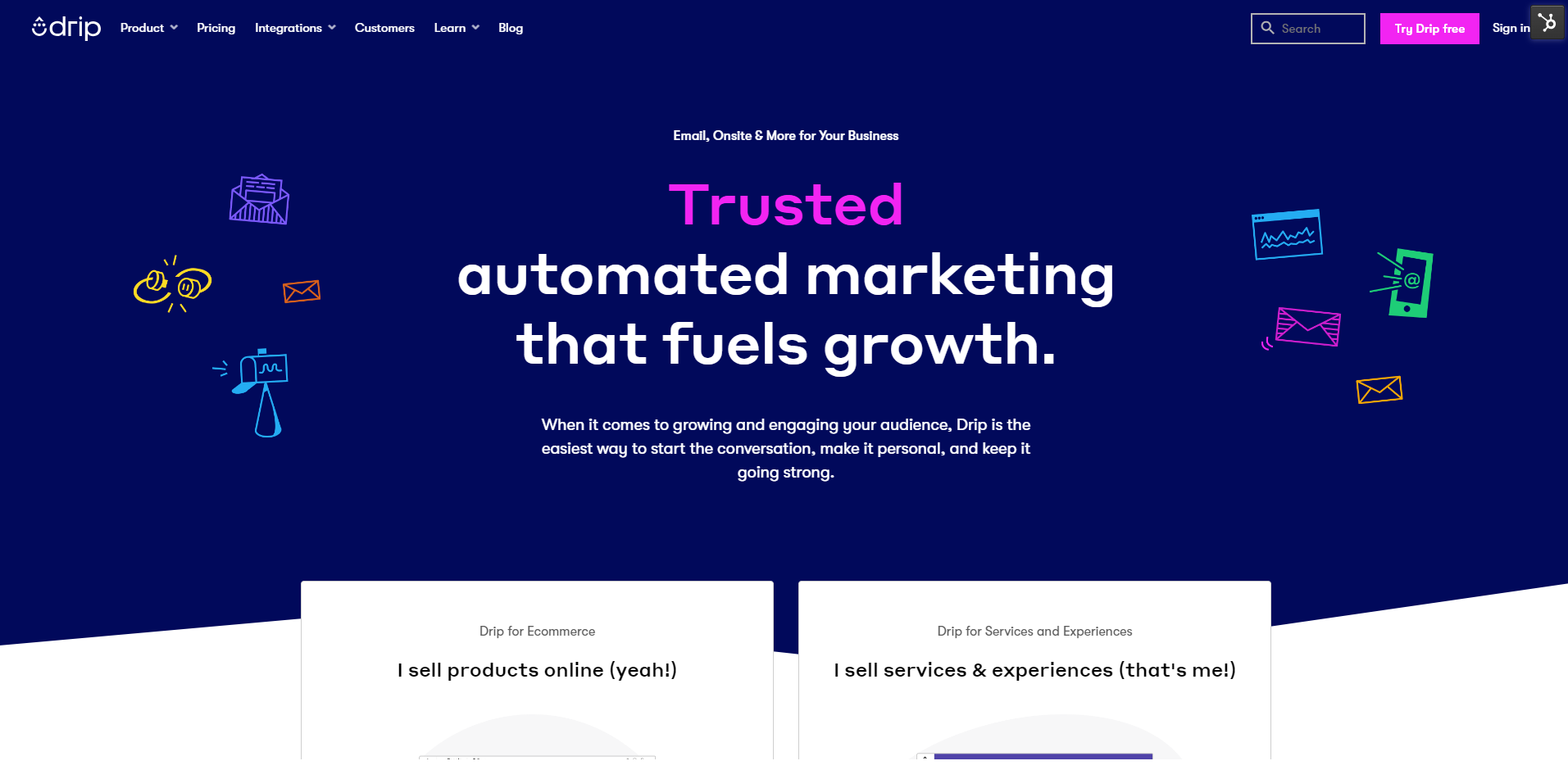 As the eagle-eyed among you will have noticed, Drip is us. We’re a marketing automation platform for ecommerce brands—particularly DTCs. With our user-friendly point-and-click email builder and pre-made workflows, we make it simple for ecommerce marketers to create email marketing and onsite campaigns that do what you need them to: drive sales and revenue.
As the eagle-eyed among you will have noticed, Drip is us. We’re a marketing automation platform for ecommerce brands—particularly DTCs. With our user-friendly point-and-click email builder and pre-made workflows, we make it simple for ecommerce marketers to create email marketing and onsite campaigns that do what you need them to: drive sales and revenue.
What Makes Drip the Best Constant Contact Alternative?
- Built for ecommerce. Constant Contact offers plenty of ecommerce functionality, but it’s ultimately a generalist platform serving a wide range of B2B and B2C brands. Meanwhile, at Drip, ecommerce is our core focus—meaning everything we do is geared toward helping ecommerce brands reach new audiences and generate more sales.
- Developed for ecommerce. Again, Constant Contact’s generalist focus forces it to factor various industries into its development plans. By contrast, every new feature, tool, or integration we introduce is built specifically for ecommerce.
- Sophisticated onsite marketing. Onsite campaigns help you generate leads and point steer customers toward products they’ll love. Constant Contact’s onsite features are limited to fairly basic onsite forms, whereas our Sleeknote—a feature-rich onsite form and popup-building platform—enables us to offer unparalleled onsite capabilities. Take total control of the design and placement of every popup, slide-in, and sidebar, and craft your onsite messaging experience with drag-and-drop ease.
- Ecommerce-focused interface. Our clutter-free UI makes it easy to find all the tools, features, and reports you need to grow sales and revenue. Contact Contact, with its far broader focus, hides all that stuff among a bunch of other functionality that isn’t super-relevant to ecommerce marketers.
- Revenue-centric reporting. Constant Contact’s reports prioritize generic email marketing metrics (think open rates and click-through rates), whereas Drip’s are focused on revenue. We make it simple to see how much money you’re generating from each individual automation and email.
- Friendly, ecommerce-focused support. Our support team will happily pull up a chair, pore over your ecommerce strategy, and offer customized recommendations for your brand—however much you pay us. That sort of personalized support is only available to Premium Constant Contact customers.
- Better value plans. Honestly, Contact Contact is pretty pricey. For instance, $50/month only gets you up to 2,500 contacts and 25,000 emails (plus basic automations and templates). With Drip, you get the same list size (and unlimited emails) for $39/month, plus our advanced onsite campaigns and dedicated customer support.
How Does Drip Compare to Constant Contact?
| Drip | Constant Contact | |
| Best Feature | Segment your whole audience based on real-time store, visitor, and marketing data. | Manage campaigns on the go from a dedicated mobile app. |
| Best For | DTC ecommerce | Nonprofits and charities (they save up to 30 percent on standard Constant Contact prices) |
| Pros | A dedicated ecommerce platform, not a generalist tool. | A better fit for non-ecommerce marketers. |
| Cons | If you’re not in ecommerce, Drip isn’t the best fit. | Lacks Drip’s advanced ecommerce functionality; comparatively expensive. |
| Pricing/Month | From $39 per month for up to 2,500 contacts and unlimited email sends. | From $12 per month for up to 500 contacts and 5,000 monthly email sends. |
| Support | Our support is rated 8.8 on G2 (vs. an average of 8.6 for marketing automation platforms) and includes live audio screen sharing to solve problems in real time. | All plans offer live chat and phone support, while Standard and Premium customers get onboarding calls too. |
2. Klaviyo
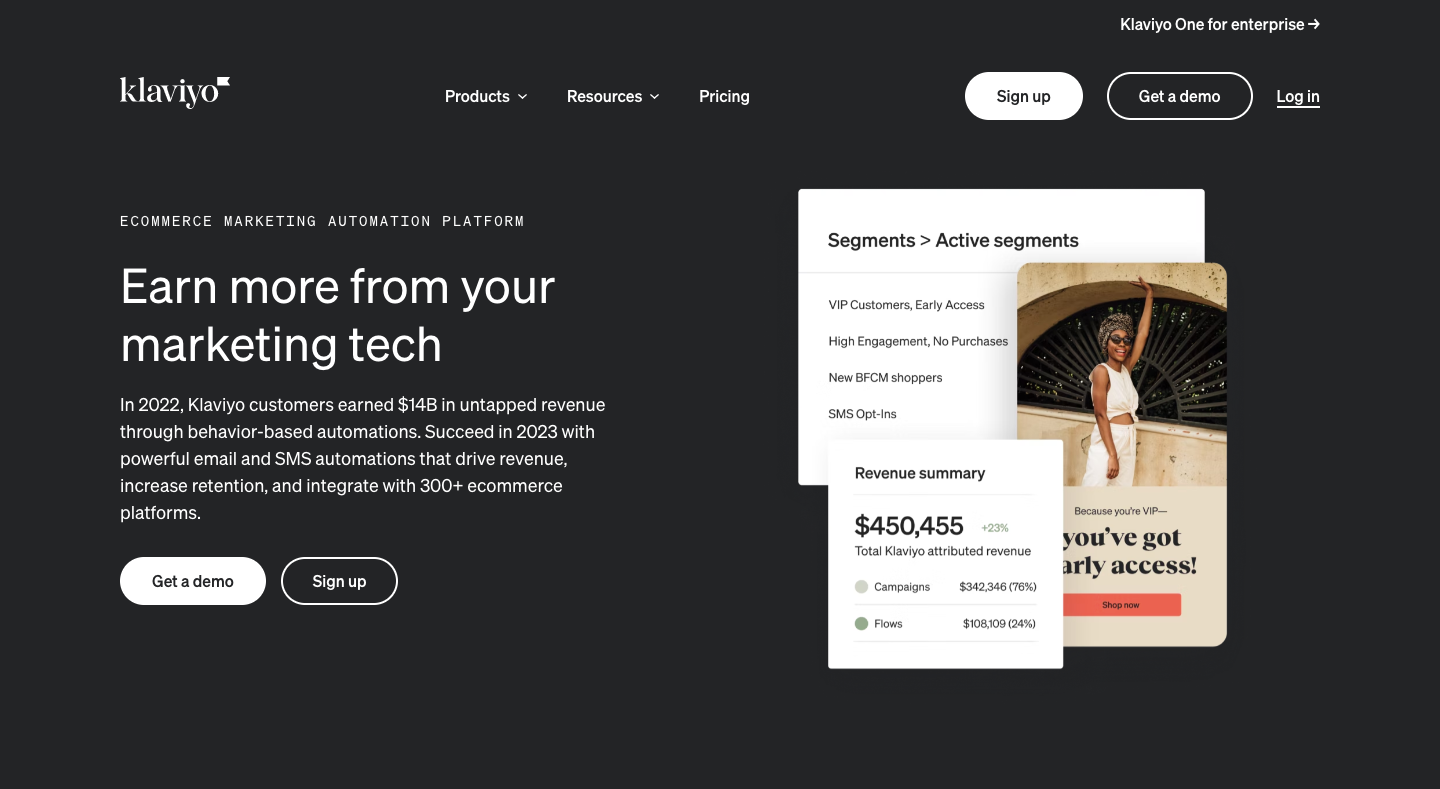 Like Drip, Klaviyo is built for ecommerce marketing. However, it’s not exactly a DIY solution; you’ll need an in-house dev team or a full-service agency to use it effectively. So it’s a better fit for enterprise-level brands with big budgets. But how does it stack up against an all-rounder like Constant Contact?
Like Drip, Klaviyo is built for ecommerce marketing. However, it’s not exactly a DIY solution; you’ll need an in-house dev team or a full-service agency to use it effectively. So it’s a better fit for enterprise-level brands with big budgets. But how does it stack up against an all-rounder like Constant Contact?
What Makes Klaviyo the Best Constant Contact Alternative?
- Dedicated to ecommerce. If you’re an ecommerce marketer (with a large-enough budget), Klaviyo is a no-brainer, because it’s built specifically for brands like yours. Constant Contact isn’t.
- Free functionality. Constant Contact doesn’t have a free plan, whereas Klaviyo gives you up to 250 contacts and 500 monthly email sends free of charge.
- Slicker templates. While Constant Contact offers twice as many templates as Klaviyo, they’re pretty basic, and the editor is quite limited. Klaviyo’s templates are far more sophisticated and come in various “flavors”, including email, SMS, and onsite forms.
- More bang for your buck. If you only go off contact list sizes and email send limits, Constant Contact is technically cheaper. But Klaviyo offers way more functionality, including built-in SMS marketing, push notifications, and more.
- Advanced reporting and analytics. Klaviyo’s analytics tools feature user-friendly—and totally customizable—dashboards to visualize your key KPIs. It also includes AI-driven predictive analytics, capable of forecasting a customer’s next actions and churn risk. Constant Contact’s reporting is perfectly decent, but as we’ve already noted, it’s geared toward engagement metrics rather than sales and revenue (and it doesn’t do all that clever predictive stuff).
How Does Klaviyo Compare to Constant Contact?
| Klaviyo | Constant Contact | |
| Best Feature | Personalization and segmentation tools allow you to create customer segments based on real-time data. | Manage campaigns on the go from a dedicated mobile app. |
| Best For | Ecommerce agencies and developers | Nonprofits and charities (they save up to 30 percent on standard Constant Contact prices) |
| Pros | Superior, revenue-focused reporting—including predictive analytics. | Technically cheaper (but with fewer features); a better fit for non-ecommerce brands. |
| Cons | Requires advanced technical skills (or, ideally, a full-service Klaviyo agency) to use it effectively. | Basic templates and lack of customization options. |
| Pricing/Month | Free for up to 250 contacts and 500 monthly email sends; paid plans priced from $45 per month for up to 1,000 contacts and 10,000 monthly email sends. | From $12 per month for up to 500 contacts and 5,000 monthly email sends. |
| Support | After the extensive onboarding program, support is limited to live chat and emails. | All plans offer live chat and phone support, while Standard and Premium customers get onboarding calls too. |
3. Mailchimp
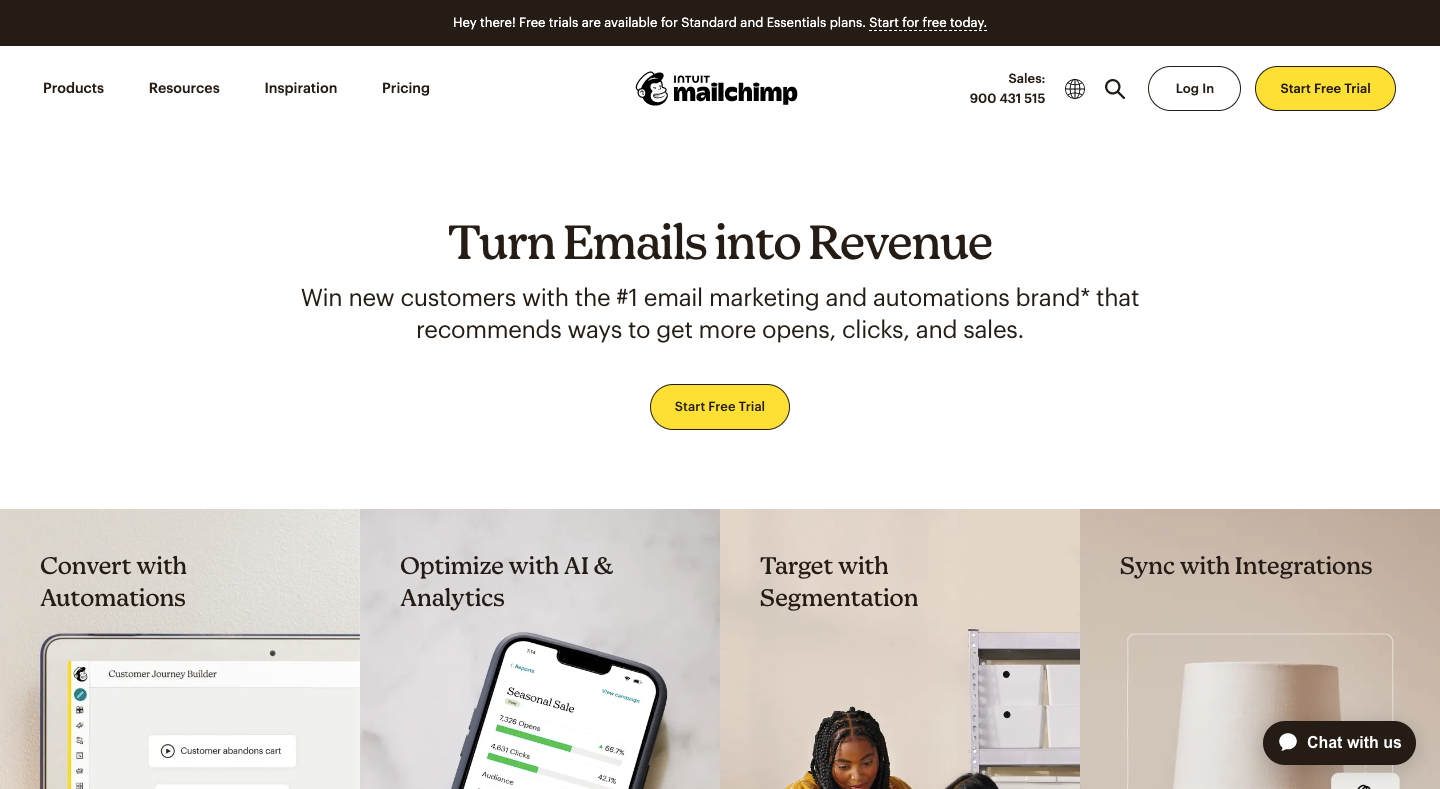 Mailchimp and Constant Contact are arguably the best-known brands in the email marketing and automation space—and both have lost ground to smaller competitors in recent times, prompting them to add new features (and increase their prices). So which of these two incumbents takes the crown?
Mailchimp and Constant Contact are arguably the best-known brands in the email marketing and automation space—and both have lost ground to smaller competitors in recent times, prompting them to add new features (and increase their prices). So which of these two incumbents takes the crown?
What Makes Mailchimp the Best Constant Contact Alternative?
- Easier to do difficult stuff. Both Mailchimp and Contact Contact are pretty user-friendly. But Mailchimp’s navigation feels more intuitive, with some nice touches like a breadcrumb menu in the campaign builder.
- Solid free plan. Mailchimp used to offer one of the most generous free plans on the market. While Mailchimp has stripped a bunch of functionality from it in recent times, it still exists, whereas Constant Contact doesn’t have one.
- Better, more flexible templates. Although Mailchimp has about 100 fewer templates than Constant Contact, it’s definitely a case of quality over quantity here. It offers more scope for customization thanks to its wider range of content blocks (including product recommendations).
- More customizable forms. Constant Contact’s onsite customization is pretty limited—you can change fonts, images, background colors, and not much else. Mailchimp’s onsite editor is far more flexible, with its drag-and-drop editor and custom fields.
- More insightful reports. With Constant Contact, reporting is limited to opens and clicks (although it does have a Google Analytics integration). Mailchimp, meanwhile, offers one of the best reporting systems on the market, incorporating click maps, geo-tracking, social reports, and more.
How Does Mailchimp Compare to Constant Contact?
| Mailchimp | Constant Contact | |
| Best Feature | Advanced analytics and reporting help marketers make data-driven decisions. | Manage campaigns on the go from a dedicated mobile app. |
| Best For | Small businesses | Nonprofits and charities (they save up to 30 percent on standard Constant Contact prices) |
| Pros | Easier to use, with better templates and onsite marketing tools; offers a free plan. | More templates (although they’re lower-quality than Mailchimp’s). |
| Cons | Less generous discounts for nonprofits and charities. | Less sophisticated reporting and more limited customization. |
| Pricing/Month | Free for up to 500 contacts and 1,000 monthly email sends; paid plans start at $9.99 per month for 500 contacts and 5,000 monthly email sends. | From $12 per month for up to 500 contacts and 5,000 monthly email sends. |
| Support | Paid plans include 24/7 support via chat and email. Phone and priority support is only available to Premium customers paying $350+ per month. | All plans offer live chat and phone support, while Standard and Premium customers get onboarding calls too. |
4. Omnisend
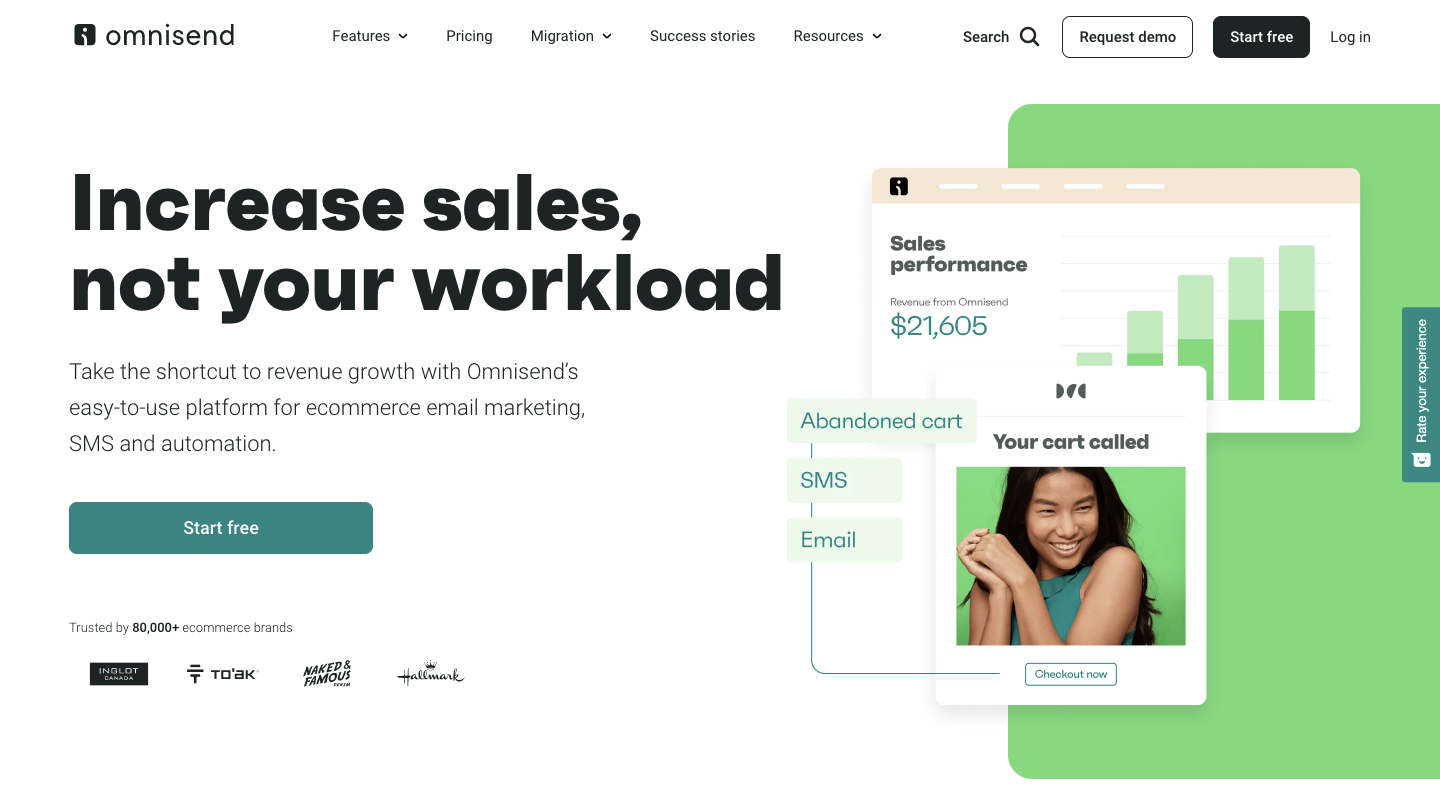 Omnisend is another ecommerce-specific marketing automation platform, allowing brands to build and automate email, SMS, and push notification campaigns. It’s used by over 100,000 businesses (including big names like Hallmark and Naked & Famous Denim). But were they right to choose it over Constant Contact?
Omnisend is another ecommerce-specific marketing automation platform, allowing brands to build and automate email, SMS, and push notification campaigns. It’s used by over 100,000 businesses (including big names like Hallmark and Naked & Famous Denim). But were they right to choose it over Constant Contact?
What Makes Omnisend the Best Constant Contact Alternative?
- Get started for free. Omnisend’s free plan certainly isn’t the best on the market, but it does allow you to send 500 emails, up to 60 SMS messages, and up to 500 push notifications to 250 contacts per month. Constant Contact doesn’t have a free plan, making Omnisend the clear winner here.
- Ecommerce-specific templates. We’ve already noted that Constant Contact offers plenty of templates, but that they’re… not the best quality. Omnisend has about half as many templates, but they’re far more attractive—and they’re even available to free users.
- More marketing channels. Both Constant Contact and Omnisend are predominantly email marketing platforms, but Omnisend also offers push notifications and SMS campaigns, giving you more ways to reach and engage your audience.
- Revenue-focused reporting. Omnisend makes it easy to find your most impactful resorts (such as revenue per campaign), whereas Constant Contact is all about engagement metrics.
- Cheaper prices. Without wishing to repeat ourselves, Constant Contact is expensive—especially considering its limited feature set. To give just one example, with Omnisend, it’s $15/month cheaper for up to 2,500 contacts (plus you get 5,000 more monthly email sends and unlimited web push notifications).
How Does Omnisend Compare to Constant Contact?
| Omnisend | Constant Contact | |
| Best Feature | Web push notifications allow brands to instantly retarget customers. | Manage campaigns on the go from a dedicated mobile app. |
| Best For | Ecommerce marketers | Nonprofits and charities (they save up to 30 percent on standard Constant Contact prices) |
| Pros | Cheaper prices and supports more marketing channels. | A better fit for brands that don’t do ecommerce. |
| Cons | If you’re not in ecommerce, you’re better off with a more generalist tool. | Costs more and does less. |
| Pricing/Month | Free to reach up to 250 contacts per month, including 500 monthly email sends, up to 60 SMS messages, and up to 500 web push notifications. Paid plans start at $16 per month to reach up to 500 contacts (including unlimited push notifications). | From $12 per month for up to 500 contacts and 5,000 monthly email sends. |
| Support | All users get 24/7 email and live chat support, while Pro and Enterprise subscribers also get a dedicated customer success manager. | All plans offer live chat and phone support, while Standard and Premium customers get onboarding calls too. |
5. Brevo (FKA Sendinblue)
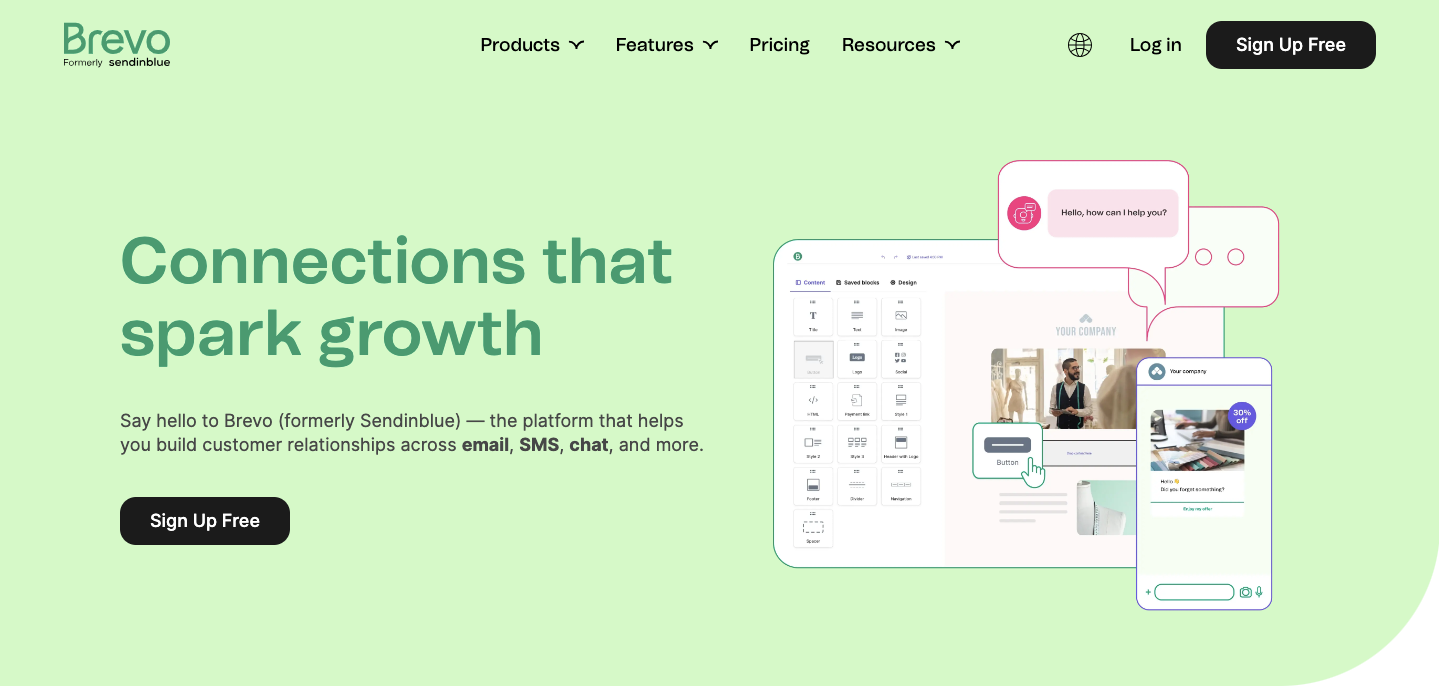 Brevo—formerly known as Sendinblue (RIP)—is one of the most budget-friendly automation platforms on the market. But its comparatively low prices don’t come at the expense of advanced marketing functionality. So it’s easy to see why Brevo is the tool of choice for 500,000+ customers in 180 countries.
Brevo—formerly known as Sendinblue (RIP)—is one of the most budget-friendly automation platforms on the market. But its comparatively low prices don’t come at the expense of advanced marketing functionality. So it’s easy to see why Brevo is the tool of choice for 500,000+ customers in 180 countries.
What Makes Brevo the Best Constant Contact Alternative?
- Superb free plan. We can’t be any clearer: you don’t get anything free with Constant Contact. But even if it did have a free plan, it’d likely struggle to compete with Brevo, which lets you send up to 300 emails a day (including transactional emails) without spending a single cent.
- Cheaper across the board. Whichever way you look at it, Brevo is far cheaper. Here’s an example: for $25/month, you get 20,000 emails and an unlimited contact list. Constant Contact’s closest alternative—25,000 emails to 2,500 contacts—is twice the price. Sheeesh.
- Reach audiences on more channels. Constant Contact offers built-in social media scheduling, which Brevo doesn’t do. On the flip side, Brevo also does push notifications, SMS marketing, and WhatsApp campaigns; you’ll need an integration to most of that with Constant Contact. So Brevo wins here, too.
- Free CRM access. Brevo offers a free CRM through its Sales Platform, which includes unlimited contacts, pipeline management, and CRM automation. Constant Contact doesn’t offer any of that stuff.
- Highly customizable onsite forms. Brevo’s drag-and-drop editor is a joy to use, allowing you to design on-brand forms and add all the data fields you need. Constant Contact’s form editor is trickier to use and offers fewer customization options.
How Does Brevo Compare to Constant Contact?
| Brevo | Constant Contact | |
| Best Feature | Send transactional emails with guaranteed 97 percent deliverability. | Manage campaigns on the go from a dedicated mobile app. |
| Best For | Low-budget email marketing | Nonprofits and charities (they save up to 30 percent on standard Constant Contact prices) |
| Pros | Includes transactional emails and a CRM with all product tiers. | Offers built-in social media scheduling. |
| Cons | Low-tier customers need to pay an extra $12/month to remove Brevo branding. | No free tier, higher prices, and fewer features. |
| Pricing/Month | Free for unlimited contacts and up to 300 emails per day. Paid plans start at $25 per month for unlimited contacts and 20,000 emails per month. | From $12 per month for up to 500 contacts and 5,000 monthly email sends. |
| Support | The $25+ per month Starter plan only offers email-based support. To receive personalized support, you’ll need to subscribe to an Enterprise plan. | All plans offer live chat and phone support, while Standard and Premium customers get onboarding calls too. |
6. ConvertKit
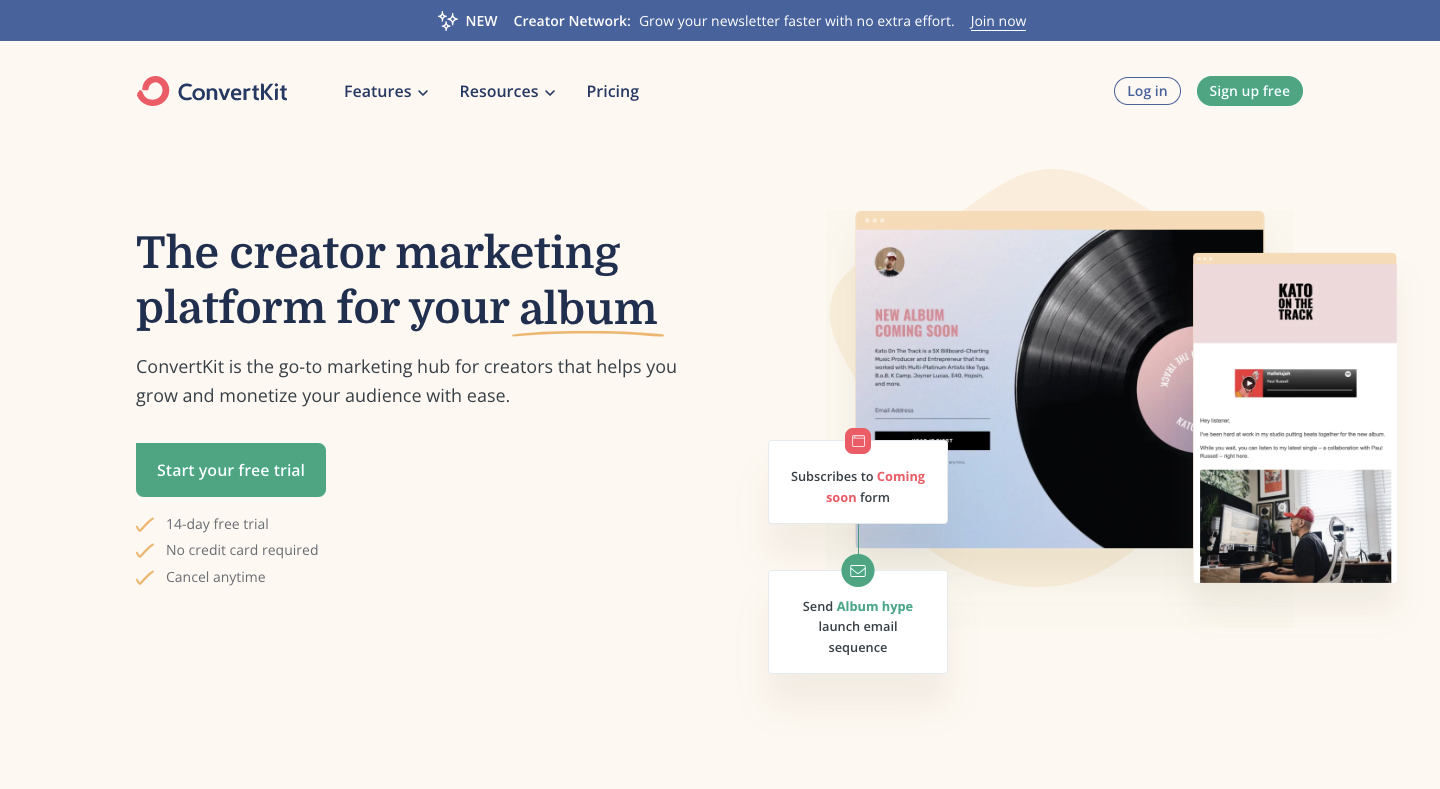 ConvertKit is a different beast to the rest of our Constant Contact alternatives. Why? Because it targets a totally different audience: content creators. If you’re a coach, author, podcaster, or musician looking for an email marketing tool to engage and monetize your audience, ConvertKit seems a compelling proposition. But how does it measure up against a heavyweight email platform like Constant Contact?
ConvertKit is a different beast to the rest of our Constant Contact alternatives. Why? Because it targets a totally different audience: content creators. If you’re a coach, author, podcaster, or musician looking for an email marketing tool to engage and monetize your audience, ConvertKit seems a compelling proposition. But how does it measure up against a heavyweight email platform like Constant Contact?
What Makes ConvertKit the Best Constant Contact Alternative?
- Inclusive referral marketing. Content creators know referral marketing is an effective way to grow their audience, so it’s worth noting that ConvertKit’s Creator Pro plan (priced at $25+ a month) offers inclusive access to SparkLoop’s referral marketing platform. Constant Contact integrates with a different referral platform, Referral Rock, but you’ll need to pay a separate subscription for it—and it’s not cheap, with prices starting at $200/month.
- Built-in creator network. All paying ConvertKit customers are welcomed into the platform’s Creator Network, allowing them to recommend—and, more importantly, be recommended by—fellow creators. Constant Contact doesn’t offer anything comparable.
- Newsletter monetization. If you have at least 10,000 subscribers, ConvertKit helps you find paid newsletter sponsorship opportunities, opening up a whole new revenue stream for your content. Again, Constant Contact isn’t really built for content creators and doesn’t have anything similar.
- Free tools. Constant Contact doesn’t have a free plan. ConvertKit does, and it’s pretty decent, allowing you to send unlimited emails to up to 1,000 contacts and create unlimited landing pages, link pages, and opt-in forms.
- Cheaper email marketing. There’s no way around it: ConvertKit is cheaper. For example, it charges $41/month to send unlimited emails to 3,000 subscribers. Constant Contact’s most similar plan, for 2,501 – 5,000 contacts and up to 50,000 email sends, costs almost twice as much.
How Does ConvertKit Compare to Constant Contact?
| ConvertKit | Constant Contact | |
| Best Feature | Integrated newsletter referral program helps creators grow their reach by leveraging their existing audience. | Manage campaigns on the go from a dedicated mobile app. |
| Best For | Content creators | Nonprofits and charities (they save up to 30 percent on standard Constant Contact prices) |
| Pros | Lots of creator-friendly tools to grow your audience and monetize your content. | More sophisticated ecommerce functionality. |
| Cons | If you’re not a content creator, ConvertKit isn’t the right choice. | Not particularly content creator-friendly; more expensive (and no free plan). |
| Pricing/Month | Free for up to 1,000 subscribers and unlimited email sends; paid plans start at $9 per month for up to 300 subscribers and unlimited sends. | From $12 per month for up to 500 contacts and 5,000 monthly email sends. |
| Support | Paying customers get live chat and email support, with priority access offered to Creator Pro subscribers. Free subscribers only get community support. | All plans offer live chat and phone support, while Standard and Premium customers get onboarding calls too. |
7. ActiveCampaign
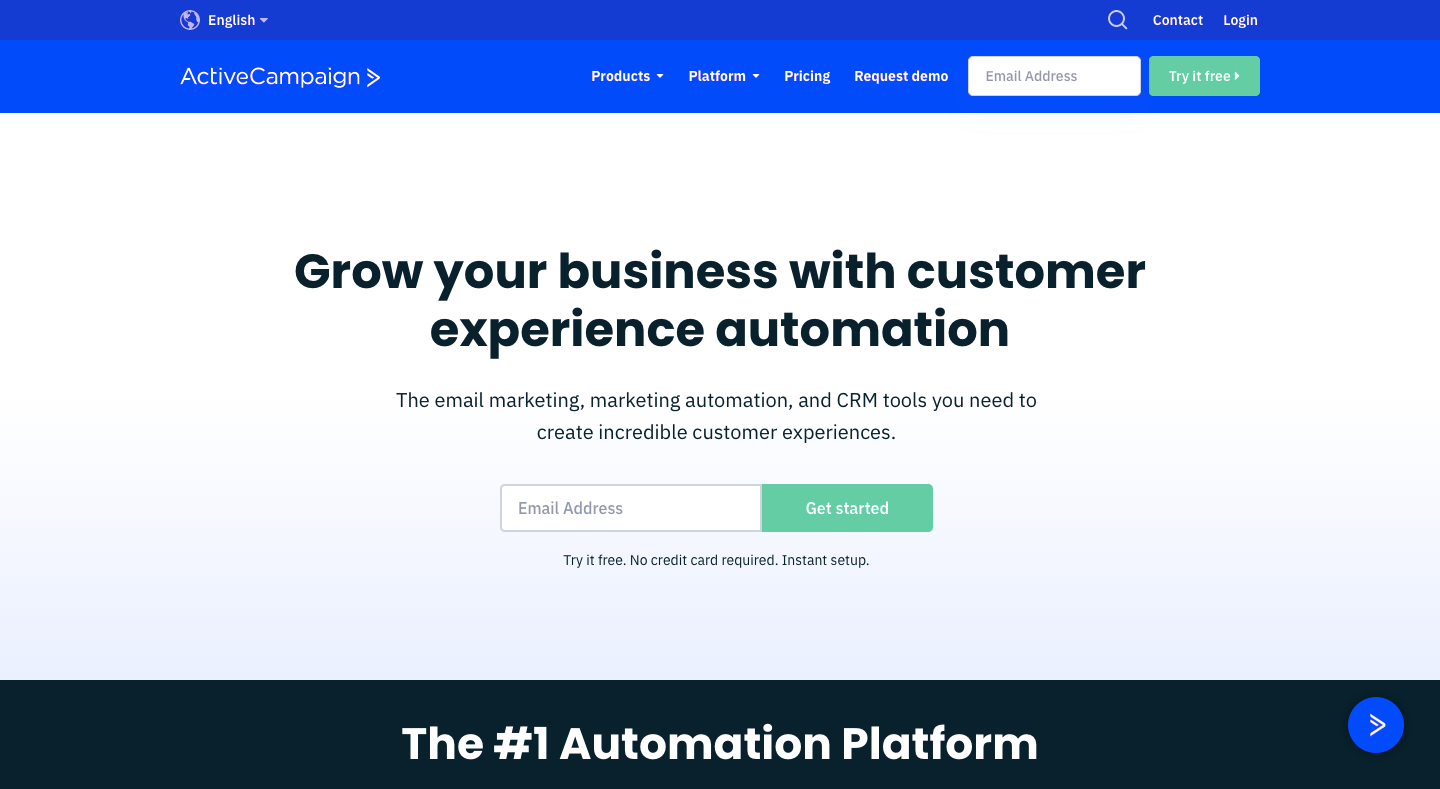 ActiveCampaign has one of the most impressive feature sets of any marketing automation platform, offering a wealth of tools designed for brands and organizations across a dozen different industries. Over 150,000 businesses in 170+ countries use it for their email campaigns.
ActiveCampaign has one of the most impressive feature sets of any marketing automation platform, offering a wealth of tools designed for brands and organizations across a dozen different industries. Over 150,000 businesses in 170+ countries use it for their email campaigns.
What Makes ActiveCampaign the Best Constant Contact Alternative?
- More advanced automation. Until recently, Constant Contact’s automations were limited to autoresponders. They’ve improved since then, but they’re not as sophisticated—or easy to use—as ActiveCampaign, which offers 850+ automation “recipes”.
- Inclusive email testing. At Plus level and above, ActiveCampaign users can access five monthly email tests via a third-party tool called Inbox Preview, allowing them to see how your emails will look across different email clients and devices. Constant Contact doesn’t have any built-in email testing capabilities.
- Predictive actions. ActiveCampaign uses machine learning to optimize campaign performance, such as customizing email send times based on when they’re most likely to be opened. You don’t get that with Constant Contact.
- More native integrations. Realistically, both platforms offer more integrations than you’ll ever need. But this is a numbers game, and ActiveCampaign has over 870 integrations, whereas Constant Contact “only” has 300+.
- Higher email deliverability. At time of writing, Email Deliverability Report ranks ActiveCampaign as the second-best email marketing tool for deliverability, while Constant Contact is down in 16th place.
How Does ActiveCampaign Compare to Constant Contact?
| ActiveCampaign | Constant Contact | |
| Best Feature | Predictive actions use machine learning to deliver customer experiences based on data, such as the best time to send emails. | Manage campaigns on the go from a dedicated mobile app. |
| Best For | Advanced marketers who need high-level automation | Nonprofits and charities (they save up to 30 percent on standard Constant Contact prices) |
| Pros | AI-driven predictive actions and built-in email testing. | Offers built-in social media marketing and scheduling. |
| Cons | Requires an integration for social media management. | Weaker automations and no predictive actions to optimize your campaigns. |
| Pricing/Month | From $29 per month for one user and unlimited emails. | From $12 per month for up to 500 contacts and 5,000 monthly email sends. |
| Support | All ActiveCampaign plans offer 24/7 email and chat-based support, but only Enterprise customers get over-the-phone support. | All plans offer live chat and phone support, while Standard and Premium customers get onboarding calls too. |
8. AWeber
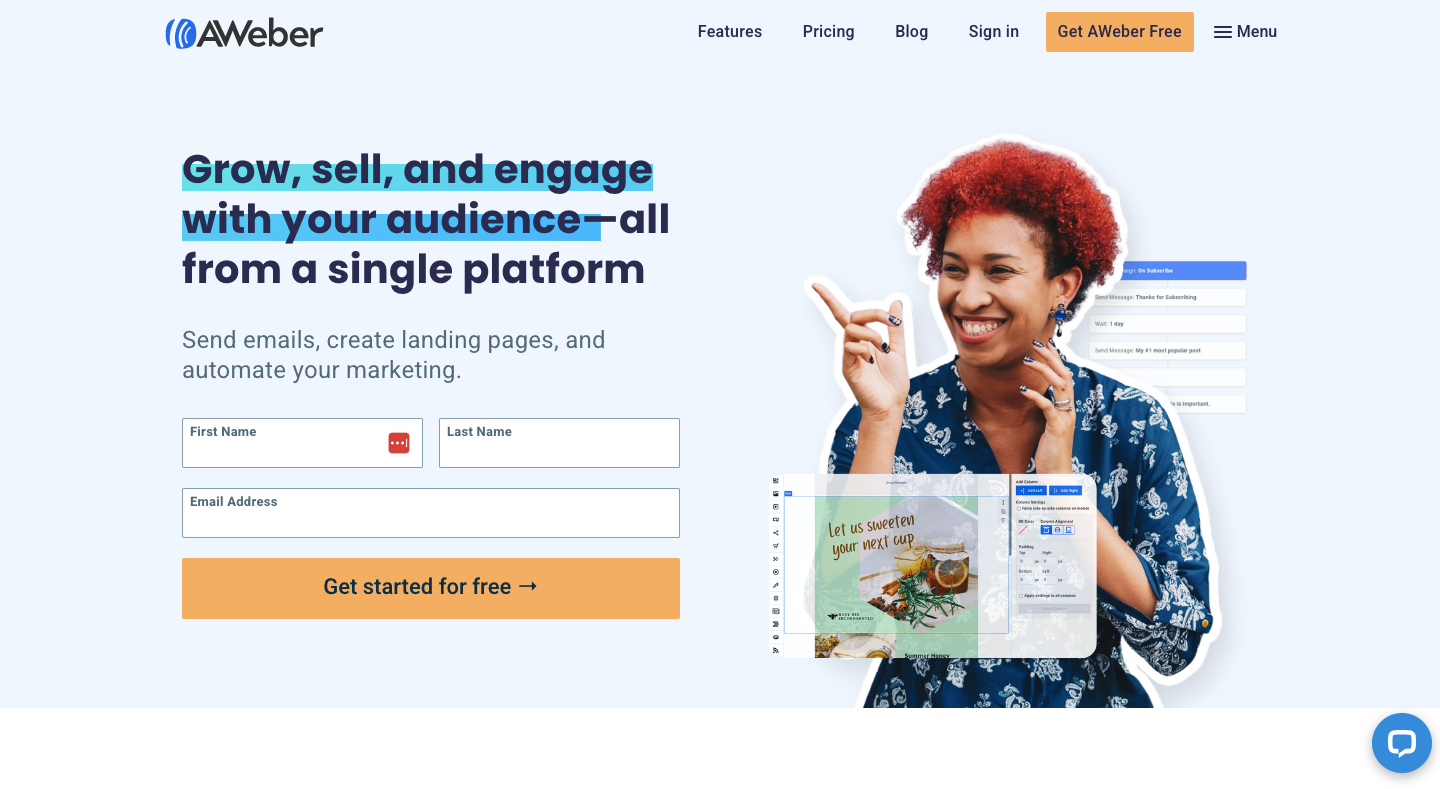 AWeber and Constant Contact are both aimed at small businesses looking for affordable, high-value email tools. Both are veterans of the email marketing scene, having hit the market way back in the 1990s. But which has the edge today?
AWeber and Constant Contact are both aimed at small businesses looking for affordable, high-value email tools. Both are veterans of the email marketing scene, having hit the market way back in the 1990s. But which has the edge today?
What Makes AWeber the Best Constant Contact Alternative?
- Solid free tier. AWeber certainly doesn’t offer the most generous free plan, allowing you to send 3,000 monthly emails to 500 subscribers. But any free functionality is better than none, and as we’ve already noted, Constant Contact doesn’t have a free tier.
- Cheaper paid plans. AWeber plans work out a lot cheaper than Constant Contact’s—especially if you’re just looking for an email platform. For just $22.50/month, AWeber lets you send unlimited emails to 2,500 subscribers. That’ll cost you more than twice as much with Constant Contact (and you don’t get unlimited email sends, either).
- More email templates. To be honest, we’re not particularly impressed with either platform’s templates—they’re a little basic, and not particularly easy to customize to your brand. But AWeber offers about three times more than Constant Contact, so it takes the win here.
- More integrations. Again, more is more here. AWeber offers 750+ integrations, which is over twice as many as Constant Contact.
- Built-in push notifications. Want to send push notifications to subscribers? You’ll need an integration to do it with Constant Contact, whereas AWeber offers push notifications on all plans—even the free one.
How Does AWeber Compare to Constant Contact?
| AWeber | Constant Contact | |
| Best Feature | Create email templates in seconds using your website or Facebook page URL. | Manage campaigns on the go from a dedicated mobile app. |
| Best For | Startups and small businesses | Nonprofits and charities (they save up to 30 percent on standard Constant Contact prices) |
| Pros | Has a free product tier and cheaper pricing across the board. | Offers built-in social scheduling and posting capabilities. |
| Cons | Lacks Constant Contact’s range of marketing channels. | If you don’t need social media management, Constant Contact works out much more expensive. |
| Pricing/Month | Free for up to 500 email subscribers and 3,000 monthly email sends; paid plans priced from $12.50 per month for up to 500 subscribers and unlimited emails. | From $12 per month for up to 500 contacts and 5,000 monthly email sends. |
| Support | All users—even free subscribers—can access 24/7 live support via phone, email, and chat (although paying customers are placed in a priority queue). | All plans offer live chat and phone support, while Standard and Premium customers get onboarding calls too. |
9. GetResponse
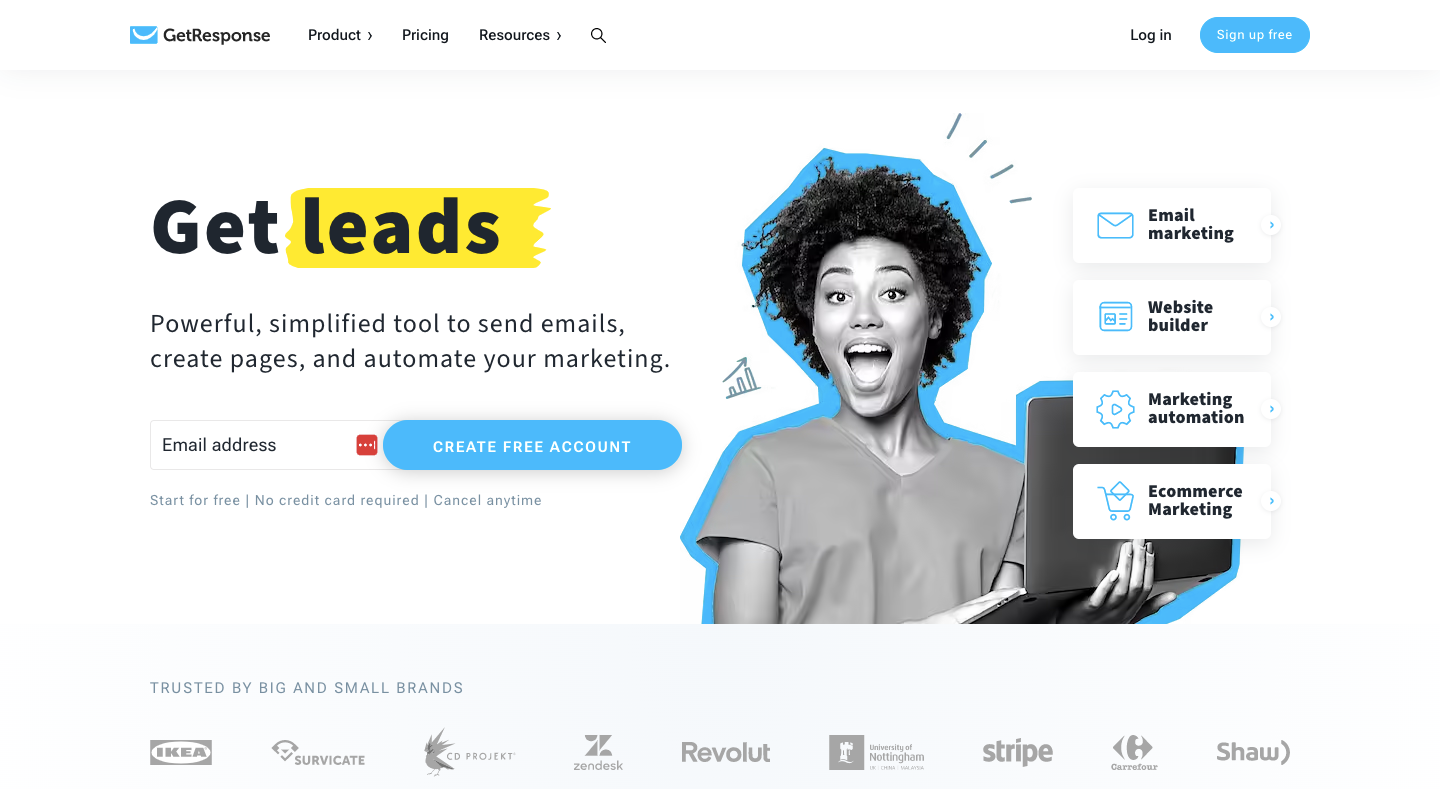 GetResponse is another of the heavyweight all-rounders, with a diverse range of brands—including Red Bull, Ikea, and Zendesk—using its email marketing and automation tools. While Constant Contact is geared toward small businesses, GetResponse claims to be a platform for everyone. So which is best?
GetResponse is another of the heavyweight all-rounders, with a diverse range of brands—including Red Bull, Ikea, and Zendesk—using its email marketing and automation tools. While Constant Contact is geared toward small businesses, GetResponse claims to be a platform for everyone. So which is best?
What Makes GetResponse the Best Constant Contact Alternative?
- Higher email deliverability. At time of writing, GetResponse is third on Email Deliverability Report’s ranking, whereas Constant Contact is one of the poorer performers at #16.
- Feature-packed free plan. GetResponse’s free plan doesn’t offer the most attractive contact list or email send limits (at 500 contacts and 2,500 monthly email sends), but it does include a ton of juicy extras, including free access to the platform’s website and landing page builders. Constant Contact doesn’t have a free tier.
- Cheaper paid plans. GetResponse doesn’t really bill itself as a low-cost platform, yet it still offers better value for money than Constant Contact. Its paid plans start at $13.30/month for 1,000 contacts and unlimited emails; Constant Contact’s closest comparable plan costs $30/month.
- AI-powered website builder. All GetResponse customers—even those on the free tier—can leverage the platform’s sophisticated, AI-powered website builder, allowing them to create a site without any coding skills. Constant Contact doesn’t have a website builder (although it does let you create basic landing pages).
- Built-in webinar hosting. A niche use case, but a potentially valuable one for some brands: GetResponse customers at Marketing Automation level and above can use the platform to host webinars. You’ll need an integration to do the same through Constant Contact.
How Does GetResponse Compare to Constant Contact?
| GetResponse | Constant Contact | |
| Best Feature | Built-in GPT-3.5-powered email generator. | Manage campaigns on the go from a dedicated mobile app. |
| Best For | Small businesses that need advanced marketing tools | Nonprofits and charities (they save up to 30 percent on standard Constant Contact prices) |
| Pros | Built-in webinar hosting and website builder; solid free plan. | Built-in social media management. |
| Cons | Doesn’t do social media scheduling (although it does have a social ads creator). | Higher prices and fewer features. |
| Pricing/Month | Free for up to 500 contacts and 2,500 monthly email sends. Paid plans start at $13.30 per month for 1,000 contacts and unlimited email sends. | From $12 per month for up to 500 contacts and 5,000 monthly email sends. |
| Support | Paid plans include 24/7 support via chat and email. Phone support is only available at top-tier MAX2 level; some MAX2 customers can also access Slack support. | All plans offer live chat and phone support, while Standard and Premium customers get onboarding calls too. |
10. HubSpot
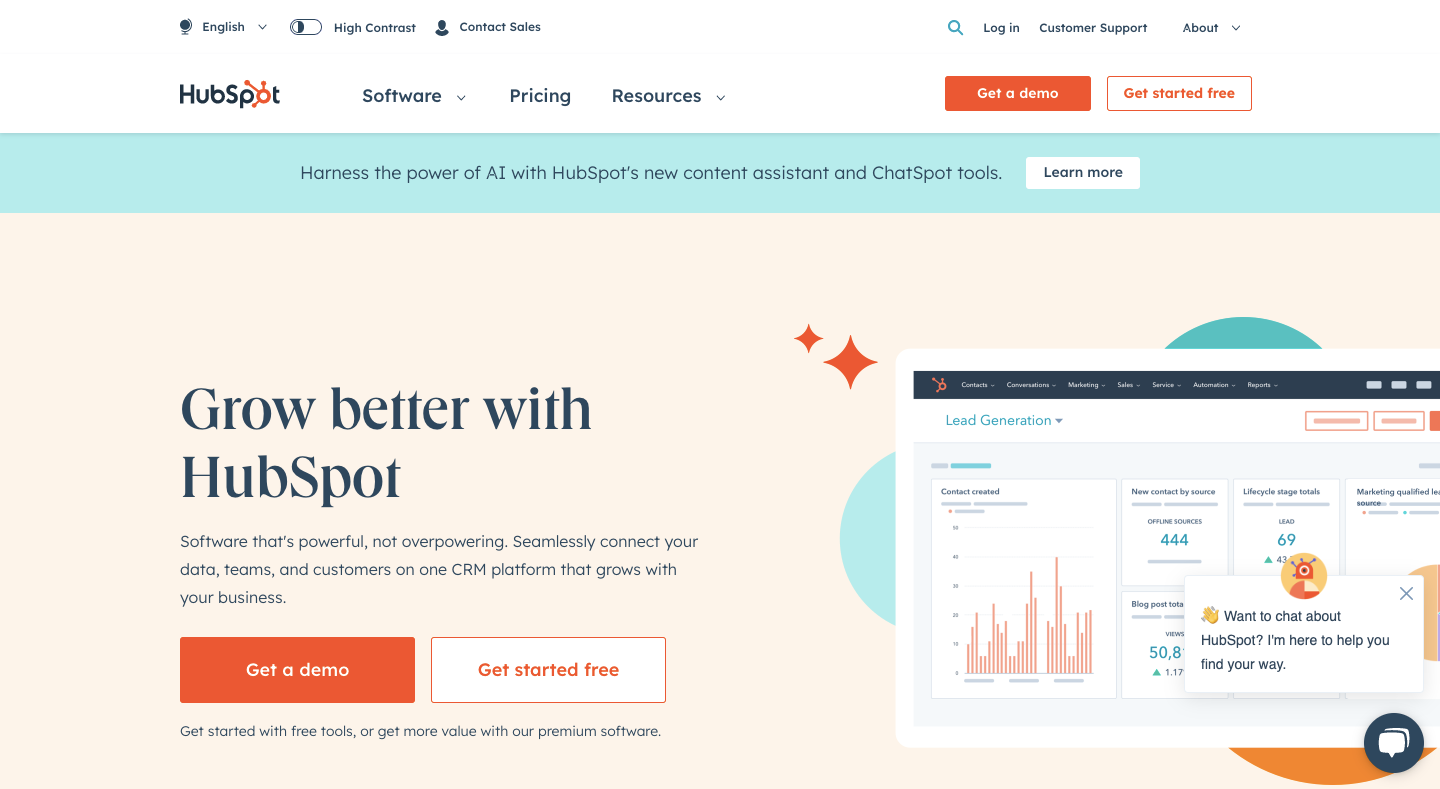 HubSpot is certainly the most feature-rich of all the Constant Contact alternatives in our roundup. So much so that you wouldn’t really describe it as an email marketing platform at all, because it does so much other stuff. That makes it hard to compare to a “pure” email tool like Constant Contact, but we’ll try our best!
HubSpot is certainly the most feature-rich of all the Constant Contact alternatives in our roundup. So much so that you wouldn’t really describe it as an email marketing platform at all, because it does so much other stuff. That makes it hard to compare to a “pure” email tool like Constant Contact, but we’ll try our best!
What Makes HubSpot the Best Constant Contact Alternative?
- Tons of free functionality. HubSpot certainly isn’t the cheapest way to send emails, but it does have a feature-packed free plan that includes an unlimited list size, 2,000 monthly email sends, and limited automations and segmentation. Constant Contact, as we’ve noted multiple times, has no free plan.
- Free CRM. Both platforms offer a built-in CRM, but HubSpot’s customer relationship management platform is one of the best on the market—and you can use it free of charge!
- Integrate with everything. There’s nothing obvious missing from Constant Contact’s library of 0ver 300 integrations, but it can’t match the 1,000+ offered by HubSpot.
- Manage multiple business functions. HubSpot’s major point of difference is its ability to combine sales, marketing, support, ops, and content management in a single platform. If that’s what you’re looking for, you won’t get it from Constant Contact.
- Powerful analytics. HubSpot’s analytics suite is one of the best on the market, incorporating all your sales, service, and marketing data to create a single source of truth. Constant Contact’s reporting is extremely basic by comparison, although it does offer a Google Analytics integration.
How Does HubSpot Compare to Constant Contact?
| HubSpot | Constant Contact | |
| Best Feature | Connect marketing, sales, content management, and customer service in a single platform. | Manage campaigns on the go from a dedicated mobile app. |
| Best For | B2B inbound marketing | Nonprofits and charities (they save up to 30 percent on standard Constant Contact prices) |
| Pros | An all-in-one sales and marketing platform with an excellent (free) CRM. | Built-in social scheduling at Standard level and above. |
| Cons | Social scheduling is only available at Professional level and above ($450+ per month). | No free plan; limited reporting/ |
| Pricing/Month | Free marketing plan includes unlimited contacts and 2,000 monthly email sends. Paid marketing plans start at $18 per month for 1,000 contacts and 5,000 monthly sends. | From $12 per month for up to 500 contacts and 5,000 monthly email sends. |
| Support | Paying customers can get 1:1 email and in-app chat support. Phone support is available at Pro level and above. | All plans offer live chat and phone support, while Standard and Premium customers get onboarding calls too. |
Frequently Asked Questions
Almost certainly. While there’s nothing fundamentally wrong with Constant Contact, it’s one of the more expensive email platforms on the market—and it doesn’t really have the feature set to back it up. If you’re looking for a low-cost email marketing tool, you’re much better off with Brevo or MailerLite. And if you’re an ecommerce marketer, you should choose a more revenue-focused platform like Drip, Klaviyo, or Omnisend.
No. Google doesn’t offer an alternative to Constant Contact. However, you can use it as a basic email marketing tool by installing a third-party plugin.
Constant Contact might be one of the best-known email marketing tools, but it’s far more limited (and expensive) than a lot of other platforms. Unless you really need built-in social media scheduling—and can’t do it via a low-cost integration—it’s hard to recommend Constant Contact over any of the other tools we’ve reviewed.
The biggest disadvantage of Constant Contact is its pricing: it works out more expensive than pretty much every other email marketing platform we’ve seen, despite offering comparatively limited functionality. Its reporting and email templates are also pretty basic.
Conclusion
There might be some niche use cases in which Constant Contact is the perfect tool for you (like if you absolutely must have a built-in social media scheduler).
But for the vast majority of email marketers, there are plenty of better—and cheaper—Constant Contact alternatives.
If you’re an ecommerce marketer, we’d strongly recommend checking out Drip’s sales and revenue-focused automation platform. We think you’ll love our simple UI, advanced, pre-built workflows, and beautiful, ecommerce-specific email and onsite templates.
But don’t take our word for it. See for yourself by signing up for your 14-day free trial today!
